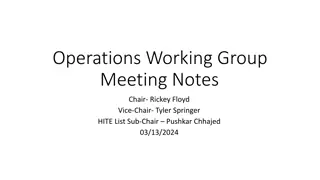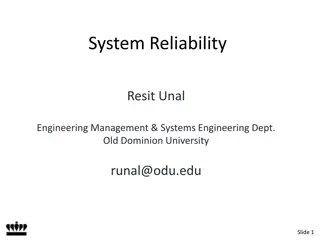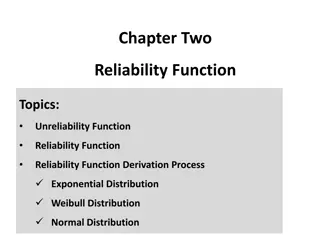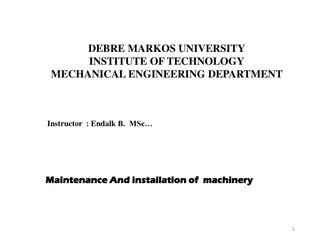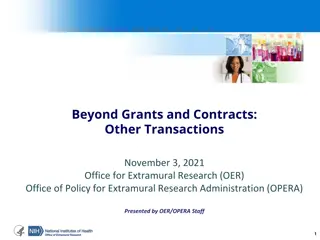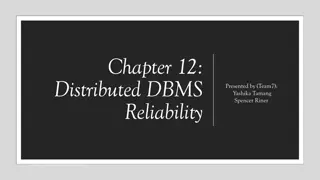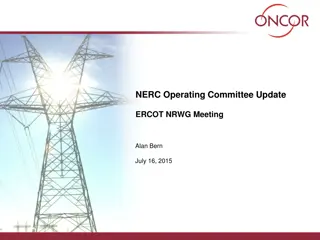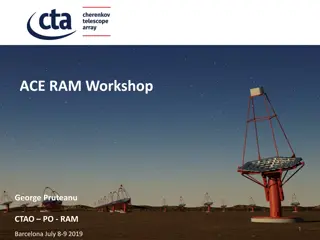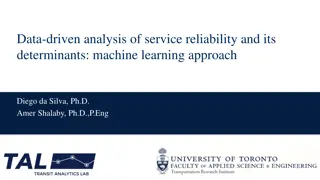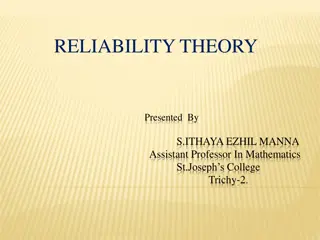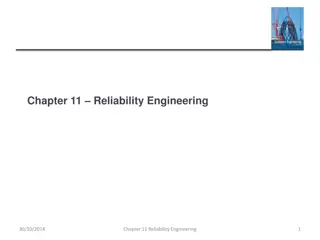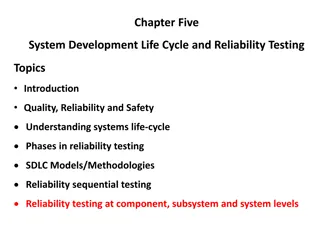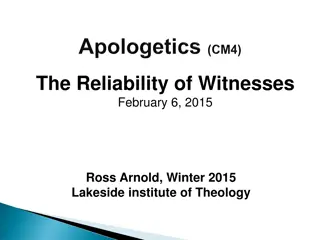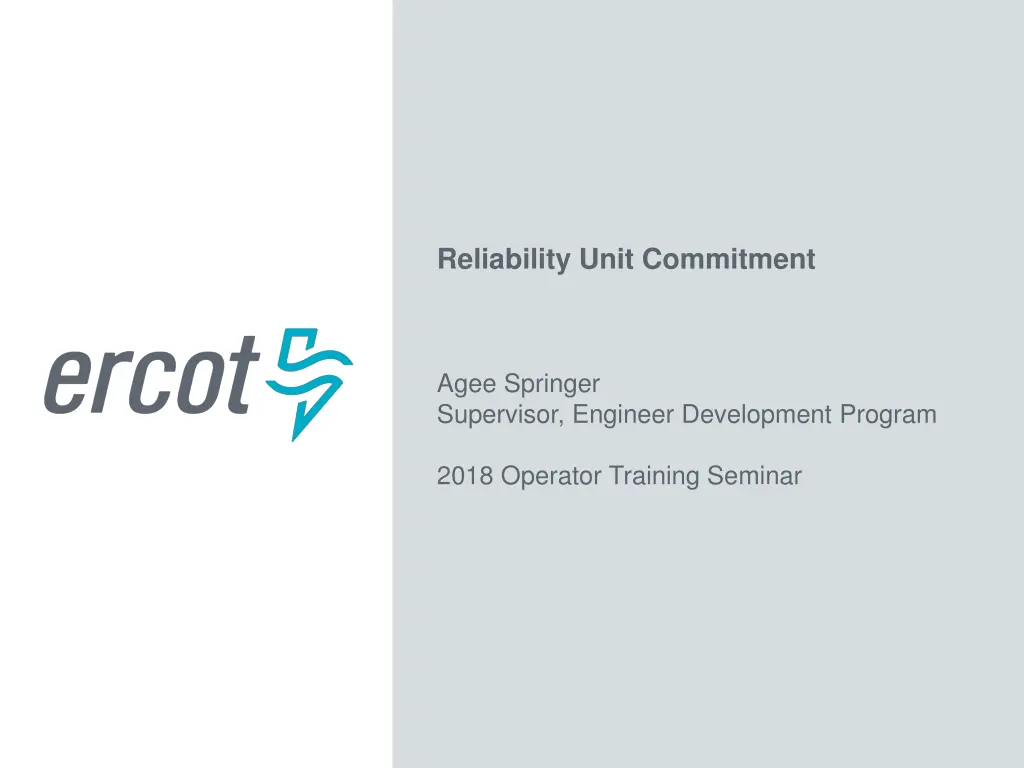
Understanding Reliability Unit Commitment Process in Energy Sector
Explore the fundamentals of Reliability Unit Commitment (RUC) process, including capacity considerations and locational factors. Discover the impact of decisions made by ERCOT and QSEs in the RUC process, with insights into the timeline and purpose of this essential energy operation.
Download Presentation

Please find below an Image/Link to download the presentation.
The content on the website is provided AS IS for your information and personal use only. It may not be sold, licensed, or shared on other websites without obtaining consent from the author. If you encounter any issues during the download, it is possible that the publisher has removed the file from their server.
You are allowed to download the files provided on this website for personal or commercial use, subject to the condition that they are used lawfully. All files are the property of their respective owners.
The content on the website is provided AS IS for your information and personal use only. It may not be sold, licensed, or shared on other websites without obtaining consent from the author.
E N D
Presentation Transcript
Reliability Unit Commitment Agee Springer Supervisor, Engineer Development Program 2018 Operator Training Seminar
Objectives Review the purpose and timeline of the Reliability Commitment process Identify the steps the RUC engine takes to make commitment recommendations Identify the impacts of decisions made by ERCOT and QSEs in the RUC process 2 PUBLIC
Todays Agenda 1. RUC Fundamentals 2. The RUC Engine 3. Control Room Analysis and Actions 4. Post-RUC Actions and Impact 3 PUBLIC
Todays Agenda 1. RUC Fundamentals 2. The RUC Engine 3. Control Room Analysis and Actions 4. Post-RUC Actions and Impact 4 PUBLIC
What is RUC? RUC is an acronym for Reliability Unit Commitment RUC ensures Enough capacity is committed to serve forecasted load Committed capacity is in the right locations 5 PUBLIC
RUC Considerations Capacity Not available to RUC When evaluating capacity, RUC differentiates between dispatchable generation and Ancillary Services AS Capacity Load Forecast AS Capacity RUC Commit Capacity that is reserved for AS is unavailable to RUC If AS will be needed to meet projected load, RUC will commit additional generation to ensure there is enough dispatchable capacity available Dispatchable Capacity 6 PUBLIC
RUC Considerations Locational When deciding which resources to commit, RUC evaluates several factors: Resource constraints Transmission constraints Resource startup and minimum energy costs This ensures generation is committed in the right locations to maintain grid reliability while minimizing costs 7 PUBLIC
Where RUC Fits 8 PUBLIC
When are RUC Studies Executed There are three RUC sequences: Weekly (WRUC) Day-Ahead (DRUC) Hourly (HRUC) These are executed at different times during the Operating Day and study different timeframes. Day 1 Day 2 9 PUBLIC
When are RUC Studies Executed Day-Ahead RUC (DRUC) Executed after the completion of the Day-Ahead Market (DAM) plus a period for COP updates, typically at 14:30 Evaluates each hour of the next Operating Day DRUC Study Period Day 1 Day 2 1430 DRUC runs 10 PUBLIC
When are RUC Studies Executed Hourly RUC (HRUC) Executed hourly Evaluates all remaining hours in the current Operating Day plus all hours of the next OD after the completion of DRUC 1800 1700 1600 DRUC Study Period HRUC runs each hour 0200 0100 0000 Day 1 Day 2 1430 DRUC runs 11 PUBLIC
RUC Results All commitments/decommitments made in each RUC run (DRUC or HRUC) are presented as recommendations to the operator The operator may accept all, some, or none of these recommendations and may also manually commit additional units before approving the RUC results Once approved, the RUC results are sent to the affected QSEs via XML message RUC commitments may also be communicated via Verbal Dispatch Instruction (VDI) 12 PUBLIC
Todays Agenda 1. RUC Fundamentals 2. The RUC Engine 3. Control Room Analysis and Actions 4. Post-RUC Actions and Impact 13 PUBLIC
RUC Input RUC Engine Overview RUC Engine Process RUC Output Offers Current Operating Plans (COPs) Resource Commitments Network Operations Model Transmission Security Analysis (TSA) Reliability Unit Commitment (RUC) Resource De- commitments Contingencies Constraint Information Load Forecast Reliability Unit Commitment Engine Additional Resource Information 14 PUBLIC
RUC Engine Inputs Tells RUC which units are committed (ON), offline but available (OFF), or unavailable (OUT). Current Operating Plans (COPs) Includes equipment ratings, transmission outages, etc. Network Operations Model Includes all current valid contingencies. Contingencies Load forecast by hour and includes current Load Distribution Factors (LDFs). Load Forecast High and Low Sustained Limits (HSL), Ancillary Service (AS) responsibilities, start time, start type (hot, warm, cold), min online time, etc. Additional Resource Information 15 PUBLIC
RUC Engine The RUC Engine is made up of two blocks The first is a Transmission Security Analysis (TSA) Transmission Security Analysis (TSA) Reliability Unit Commitment (RUC) The second is the Reliability Unit Commitment (RUC) RUC Engine These two steps are looped until a satisfactory result is reached 16 PUBLIC
RUC Engine 1. Determine initial unit commitment Occurs in the RUC block Resources that have previously committed (through DAM, earlier RUCs, and self-commitments) are optimally dispatched to meet load forecast Additional resources may be committed if existing generation is not sufficient. Transmission constraints are not considered Transmission Security Analysis (TSA) Reliability Unit Commitment (RUC) RUC Engine 17 PUBLIC
RUC Engine Three Part Offers Offers When evaluating resources for commitment, the RUC block looks at Startup Offer (if applicable) Minimum Energy Offer Transmission Security Analysis (TSA) Reliability Unit Commitment (RUC) (RUC) Reliability Unit Commitment The Energy Offer Curve is not used when making a commitment decision RUC Engine Energy Offer Curve Startup Offer Minimum Energy Offer Cost per hour at LSL Cost up to LSL ($/Start) ($/MWh) 18 PUBLIC
RUC Engine 2. Security analysis of initial dispatch solution Dispatch solution from RUC block is provided to the TSA block A security analysis is performed that considers both the base case and contingency conditions A list of binding and violated constraints is generated Transmission Security Analysis (TSA) Reliability Unit Commitment (RUC) RUC Engine 19 PUBLIC
RUC Engine 3. Determine revised unit commitments List of binding/violated constraints from the TSA block is provided to the RUC block These constraints are then enforced in the RUC block Online units are optimally re-dispatched and additional generation is committed as needed to resolve the constraints Transmission Security Analysis (TSA) Reliability Unit Commitment (RUC) RUC Engine 20 PUBLIC
RUC Engine 4. Security analysis of revised dispatch solution Dispatch solution from the latest RUC block run is provided to the TSA block A security analysis is performed that considers both the base case and contingency conditions A list of binding and violated constraints is generated Transmission Security Analysis (TSA) Reliability Unit Commitment (RUC) RUC Engine 21 PUBLIC
RUC Engine Steps 3 and 4 are looped until The TSA shows all constraints have been resolved OR There are no units that can be committed to resolve any remaining constraints Transmission Security Analysis (TSA) Reliability Unit Commitment (RUC) RUC Engine 22 PUBLIC
RUC Engine Outputs Presented as recommendations to the ERCOT Operator Operator must review and may make changes manually Resource Commitments Resource De- commitments Detailed information on contingency, overloaded element, ratings and flows, unit shift factors, etc. Presented as informational to the Operator to assist in analysis Constraint Information 23 PUBLIC
Todays Agenda 1. RUC Fundamentals 2. The RUC Engine 3. Control Room Analysis and Actions 4. Post-RUC Actions and Impact 24 PUBLIC
Control Room Activities Once the RUC sequence has completed, the Operator reviews multiple screens These screens contain the results of the study as well as details on how RUC arrived at its recommendations The Operator uses this information to make final commitment decisions 25 PUBLIC
MMS Displays The Commitment/Decommitment Analysis display gives the operator an overview of RUC recommendations Hours where commitment is recommended are highlighted Reason for commitment indicated by color Other unit information (startup type, min online time, HSL/LSL, etc.) is also shown 26 PUBLIC
MMS Displays The Operator may click on a highlighted hour, bringing up the Resource to Constraint Details display 27 PUBLIC
MMS Displays The Operator may click on a highlighted hour, bringing up the Resource to Constraint Details display Shows all constraints that were binding for that hour Shows shift factor for the selected resource on each constraint Shows the flow and shadow price at the end of the RUC solution for each constraint 28 PUBLIC
MMS Displays If the Operator needs additional information, a Suggestion Plan can be generated Gives detailed information for a single constraint in a single hour (e.g. constraint A in HE 17) Allows the Operator to see if a suggested commitment is reasonable or to identify other impactful units if additional commitments are needed 29 PUBLIC
MMS Displays For each unit, the Suggestion Plan shows Final MW dispatch for each unit The MW impact the unit had on a constraint as a result Whether the unit was selected by RUC for commitment 30 PUBLIC
MMS Displays The Commitment/Decommitment Summary page is then use to finalize the commitment decisions Suggested units are automatically entered The Operator may manually add or remove units A reason must be entered for all commitments and manual actions 31 PUBLIC
Making Commitment Decisions While the RUC tool makes suggestions, it is the Operator that is ultimately responsible for making commitment decisions Several factors go into deciding these outcomes 32 PUBLIC
Making Commitment Decisions Possible reasons for deciding not to commit a unit recommended by RUC: Evaluate Later:RUC suggestion is valid but the unit s start time allows for the decision to be deferred until a later HRUC run. Short Start: RUC suggestion is valid but the unit has a start time of <1 hour. A review of load forecast, weather forecast, COP data, and additional real-time studies has shown the unit is not needed. 33 PUBLIC
Making Commitment Decisions Possible reasons for deciding to accept a RUC recommendation: Capacity: Unit is needed to ensure adequate system- wide capacity Contingency: Unit is needed to manage congestion. The specific contingency will be entered as the Reason for commitment. Valley Import: Specific reason given for the Valley Import GTC 34 PUBLIC
Making Commitment Decisions Possible reasons for manually committing a unit that was not recommended by RUC: Voltage Support: The RUC tool cannot see voltage contingencies. Must be identified in additional study and committed manually. Forced outage occurred after RUC run was initiated. A review of load forecast, weather forecast, COP data, and additional real-time studies has shown the unit is needed 35 PUBLIC
Todays Agenda 1. RUC Fundamentals 2. The RUC Engine 3. Control Room Analysis and Actions 4. Post-RUC Actions and Impact 36 PUBLIC
Responsibilities after a RUC Once a decision to commit a unit has been reached, both ERCOT and the QSE have defined responsibilities: ERCOT: QSE: Acknowledges receipt of RUC and updates COP to confirm RUC status Updates Energy Offer Curve for RUC status Communicates the start interval and duration for which the Resource is required to be at least LSL The communication may be electronic or verbal 37 PUBLIC
Responsibilities after a RUC When a QSE receives a RUC instruction, it has two options for how to proceed: The QSE may choose to go ONRUC The QSE may choose to buy-back the RUCed hours and go ONOPTOUT Each option has different operational and financial implications The resource must still be online for all RUCed hours regardless of which option is chosen 38 PUBLIC
Going ONRUC Operational Impacts If the QSE elects to go ONRUC All energy above LSL is subject to an offer floor of $1500 The QSE may update the Energy Offer Curve by the end of the Adjustment Period ERCOT will update it automatically if the QSE does not The Reliability Deployment Price Adder will be triggered for all other online units Energy Offer Curve $1500 LSL HSL 39 PUBLIC
Going ONRUC Financial Impact If the QSE elects to go ONRUC ERCOT guarantees the QSE will recover its Start-up and Minimum Energy Costs QSE must actually incur the costs Start-up cost only paid if the unit start was due to the RUC instruction Minimum Energy Costs Startup Costs Costs Incurred 40 PUBLIC
Going ONRUC Financial Impact RUC Guaranteed Amount Make-Whole Payment Minimum Energy Costs $ Real-Time Revenue less Incremental Costs Startup Costs Revenues Received Costs Incurred This means the QSE will receive a make-whole payment if revenue is less than costs 41 PUBLIC
Going ONRUC Financial Impact RUC Guaranteed Amount Claw-Back Charge Minimum Energy Costs Real-Time Revenue less Incremental Costs $ Startup Costs Revenues Received Costs Incurred However, the QSE may receive a claw-back charge for revenues beyond the RUC guaranteed amount 42 PUBLIC
Going ONOPTOUT Operational Impacts If the QSE elects to go ONOPTOUT The resource must still start/run for the all RUCed hours No $1500 floor for energy Unit is dispatched normally according to its Energy Offer Curve The Reliability Deployment Price Adder is not triggered Energy Offer Curve $ / MWh 43 PUBLIC
Going ONOPTOUT Financial Impact No RUC financial settlements apply for resources that elect to go ONOPTOUT This means there is no claw-back charge for any profits made during the RUC hours However, there is also no make-whole payment if revenue is less than costs 44 PUBLIC
How to Opt-out of a RUC Instruction? When a QSE receives a RUC instruction, the COP should be updated to reflect the intended opt-out decision (ONRUC or ONOPTOUT) for future hours However, with the implementation of NPRR744 in 2017, the COP update does not constitute a decision to opt-out The determination of whether the resource has opted- out is now based on the telemetered resource status 45 PUBLIC
How to Opt-out of a RUC Instruction? In order to opt-out of a RUC instruction, the QSE must telemeter a status of ONOPTOUT in the first SCED interval during the RUC block where the unit is online and available for SCED dispatch This means If the unit is offline prior to the RUC, the QSE must telemeter ONOPTOUT for the first SCED interval after the unit exits STARTUP If the RUC is extending a unit already online, the QSE must telemeter ONOPTOUT for the first SCED interval of the RUC block 46 PUBLIC
How to Opt-out of a RUC Instruction? Some things to note: Any online telemetered status (ON, ONREG, etc.) that is not ONOPTOUT is treated as ONRUC by SCED The opt-out decision is recorded automatically in the first SCED interval and cannot be changed for the remainder of the RUC block The first available SCED interval must occur in the first hour of the RUC block in order to opt-out If the unit fails to start in the first hour, it cannot opt-out and will be considered ONRUC when it comes online 47 PUBLIC
How to Opt-out of a RUC Instruction? Some things to note: Any changes to the telemetered resource status after the opt-out decision has been made will be automatically overridden by SCED back to either ONRUC or ONOPTOUT depending on the decision The ERCOT Operator cannot override an opt-out decision once it has been made 48 PUBLIC
Opting-out: Examples Consider the following scenario: Unit A has been committed for HE 15 through HE 18. The unit is initially offline. SCED Timestamp SCED Timestamp SCED Timestamp SCED Timestamp SCED Timestamp SCED Timestamp SCED Timestamp SCED Timestamp Scenario 1 Scenario 1 Scenario 1 Scenario 1 Scenario 1 Scenario 1 Scenario 1 Scenario 1 Scenario 2 Scenario 2 Scenario 2 Scenario 2 Scenario 2 Scenario 2 Scenario 3 Scenario 3 Scenario 3 Scenario 3 Scenario 4 Scenario 4 13:50 13:50 13:50 13:50 13:50 13:50 13:50 13:50 STARTUP STARTUP STARTUP STARTUP STARTUP STARTUP STARTUP STARTUP OFF OFF OFF OFF OFF OFF OFF OFF OFF OFF STARTUP STARTUP 13:55 13:55 13:55 13:55 13:55 13:55 13:55 13:55 STARTUP STARTUP STARTUP STARTUP STARTUP STARTUP STARTUP STARTUP OFF OFF OFF OFF OFF OFF STARTUP STARTUP STARTUP STARTUP STARTUP STARTUP 14:00 (start of RUC) 14:00 (start of RUC) 14:00 (start of RUC) 14:00 (start of RUC) 14:00 (start of RUC) 14:00 (start of RUC) 14:00 (start of RUC) 14:00 (start of RUC) ONOPTOUT ONOPTOUT ONOPTOUT ONOPTOUT ONOPTOUT ONOPTOUT ONOPTOUT ONOPTOUT STARTUP STARTUP STARTUP STARTUP STARTUP STARTUP STARTUP STARTUP STARTUP STARTUP ON ON 14:05 14:05 14:05 14:05 14:05 14:05 14:05 14:05 ONOPTOUT ONOPTOUT ONOPTOUT ONOPTOUT ONOPTOUT ONOPTOUT ONOPTOUT ONOPTOUT STARTUP STARTUP STARTUP STARTUP STARTUP STARTUP ONRUC ONRUC ONRUC ONRUC ONOPTOUT ONOPTOUT 14:10 14:10 14:10 14:10 14:10 14:10 14:10 14:10 ONOPTOUT ONOPTOUT ONOPTOUT ONOPTOUT ONOPTOUT ONOPTOUT ONOPTOUT ONOPTOUT ONOPTOUT ONOPTOUT ONOPTOUT ONOPTOUT ONOPTOUT ONOPTOUT ONRUC ONRUC ONRUC ONRUC ONOPTOUT ONOPTOUT 14:15 14:15 14:15 14:15 14:15 14:15 14:15 14:15 ONOPTOUT ONOPTOUT ONOPTOUT ONOPTOUT ONOPTOUT ONOPTOUT ONOPTOUT ONOPTOUT ONOPTOUT ONOPTOUT ONOPTOUT ONOPTOUT ONOPTOUT ONOPTOUT ONOPTOUT ONOPTOUT ONOPTOUT ONOPTOUT ONOPTOUT ONOPTOUT 14:20 14:20 14:20 14:20 14:20 14:20 14:20 14:20 ONOPTOUT ONOPTOUT ONOPTOUT ONOPTOUT ONOPTOUT ONOPTOUT ONOPTOUT ONOPTOUT ONOPTOUT ONOPTOUT ONOPTOUT ONOPTOUT ONOPTOUT ONOPTOUT ONOPTOUT ONOPTOUT ONOPTOUT ONOPTOUT ONOPTOUT ONOPTOUT RESULT RESULT RESULT RESULT RESULT RESULT RESULT Opt-out Opt-out Opt-out Opt-out Opt-out Opt-out Opt-out Opt-out Opt-out Opt-out Opt-out Opt-out RUC RUC RUC RUC Interval SCED uses to determine opt-out decision 49 PUBLIC
Opting-out: Examples Consider the following scenario: Unit B has been committed for HE 15 through HE 18. The unit was self-scheduled through HE 14 and RUC is extending the commitment. SCED Timestamp SCED Timestamp SCED Timestamp SCED Timestamp SCED Timestamp SCED Timestamp Scenario 1 Scenario 1 Scenario 1 Scenario 1 Scenario 1 Scenario 1 Scenario 2 Scenario 2 Scenario 2 Scenario 2 Scenario 3 Scenario 3 13:50 13:50 13:50 13:50 13:50 13:50 ON ON ON ON ON ON ON ON ON ON ON ON 13:55 13:55 13:55 13:55 13:55 13:55 ON ON ON ON ON ON ON ON ON ON ON ON 14:00 (start of RUC) 14:00 (start of RUC) 14:00 (start of RUC) 14:00 (start of RUC) 14:00 (start of RUC) 14:00 (start of RUC) ONOPTOUT ONOPTOUT ONOPTOUT ONOPTOUT ONOPTOUT ONOPTOUT ON ON ON ON ONRUC ONRUC 14:05 14:05 14:05 14:05 14:05 14:05 ONOPTOUT ONOPTOUT ONOPTOUT ONOPTOUT ONOPTOUT ONOPTOUT ONOPTOUT ONOPTOUT ONOPTOUT ONOPTOUT ONRUC ONRUC 14:10 14:10 14:10 14:10 14:10 14:10 ONOPTOUT ONOPTOUT ONOPTOUT ONOPTOUT ONOPTOUT ONOPTOUT ONOPTOUT ONOPTOUT ONOPTOUT ONOPTOUT ONRUC ONRUC 14:15 14:15 14:15 14:15 14:15 14:15 ONOPTOUT ONOPTOUT ONOPTOUT ONOPTOUT ONOPTOUT ONOPTOUT ONOPTOUT ONOPTOUT ONOPTOUT ONOPTOUT ONOPTOUT ONOPTOUT 14:20 14:20 14:20 14:20 14:20 14:20 ONOPTOUT ONOPTOUT ONOPTOUT ONOPTOUT ONOPTOUT ONOPTOUT ONOPTOUT ONOPTOUT ONOPTOUT ONOPTOUT ONOPTOUT ONOPTOUT RESULT RESULT RESULT RESULT RESULT Opt-out Opt-out Opt-out Opt-out Opt-out RUC RUC RUC RUC Interval SCED uses to determine opt-out decision 50 PUBLIC


